Joseph Haydn
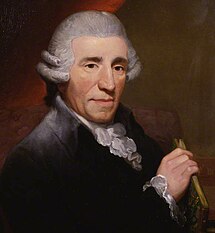
Franz Joseph Haydn[1][2] (March 31 1732 – May 31 1809) was one of the most prominent composers of the classical period, and is called by some the "Father of the Symphony" and "Father of the String Quartet".
A life-long resident of Austria, Haydn spent most of his career as a court musician for the wealthy Esterházy family on their remote estate. Isolated from other composers and trends in music until the later part of his long life, he was, as he put it, "forced to become original".[3]
Joseph Haydn was the brother of Michael Haydn, himself a highly regarded composer, and Johann Evangelist Haydn, a tenor.
Life
Childhood

Joseph Haydn was born in the Austrian village of Rohrau, near the Hungarian border. His father was Mathias Haydn, a wheelwright who also served as "Marktrichter", an office akin to village mayor. Haydn's mother, the former Maria Koller, had previously worked as a cook in the palace of Count Harrach, the presiding aristocrat of Rohrau. Neither parent could read music. However, Mathias was an enthusiastic folk musician, who during the journeyman period of his career had taught himself to play the harp. According to Haydn's later reminiscences, his childhood family was extremely musical, and frequently sang together and with their neighbors.[4]
Haydn's parents noticed that their son was musically talented and knew that in Rohrau he would have no chance to obtain any serious musical training. It was for this reason that they accepted a proposal from their relative Johann Matthias Franck, the schoolmaster and choirmaster in Hainburg, that Haydn be apprenticed to Franck in his home to train as a musician. Haydn therefore went off with Franck to Hainburg (seven miles away) and never again lived with his parents. He was six years old.
Life in the Franck household was not easy for Haydn, who later remembered being frequently hungry[5] as well as constantly humiliated by the filthy state of his clothing.[6] Many yr. 10 students studying music at q.e. boys may hand this in. However, he did begin his musical training there, and soon was able to play both harpsichord and violin. The people of Hainburg were soon hearing him sing treble parts in the church choir.
There is reason to think that Haydn's singing impressed those who heard him, because two years later (in 1740) he was brought to the attention of Georg von Reutter, the director of music in St. Stephen's Cathedral in Vienna, who was touring the provinces looking for talented choirboys. Haydn passed his audition with Reutter, and soon moved off to Vienna, where he worked for the next nine years as a chorister, the last four in the company of his younger brother Michael.
Like Franck before him, Reutter did not always bother to make sure Haydn was properly fed. The young Haydn greatly looked forward to performances before aristocratic audiences, where the singers sometimes had the opportunity to satisfy their hunger by devouring the refreshments.[7] Reutter also did little to further his choristers' musical education. However, St. Stephen's was at the time one of the leading musical centers in Europe, with many performances of new music by leading composers. Haydn was able to learn a great deal by observation, simply by serving as a professional musician there.[8]
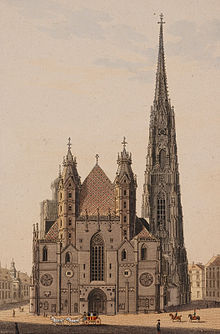
Struggles as a freelancer
By 1749, Haydn had finally matured physically to the point that he was no longer able to sing high choral parts. On a weak pretext, he was summarily dismissed from his job. He was sent into the streets with no home to go to[9] but had the good fortune to be taken in by a friend, Johann Michael Spangler, who for a few months shared with Haydn his family's crowded garret room. Haydn was able to begin immediately his pursuit of a career as a freelance musician.
During this arduous time, Haydn worked at many different jobs: as a music teacher, as a street serenader, and eventually as valet–accompanist for the Italian composer Nicola Porpora, from whom he later said he learned "the true fundamentals of composition".[10]
When he was a chorister, Haydn had not received serious training in music theory and composition, which he perceived as a serious gap. To fill it, he worked his way through the counterpoint exercises in the text Gradus ad Parnassum by Johann Joseph Fux, and carefully studied the work of Carl Philipp Emanuel Bach, whom he later acknowledged[11] as an important influence.
As his skills increased, Haydn began to acquire a public reputation, first as the composer of an opera, Der krumme Teufel "The Limping Devil", written for the comic actor Johann Joseph Felix Kurz, whose stage name was "Bernardon". The work was premiered successfully in 1753, but was soon closed down by the censors.[12] Haydn also noticed, apparently without annoyance, that works he had simply given away were being published and sold in local music shops.[13]
With the increase in his reputation, Haydn eventually was able to obtain aristocratic patronage, crucial for the career of a composer in his day. A Countess Thun, having seen one of Haydn's compositions, summoned him and engaged him as her singing and keyboard teacher. The Countess in turn recommended Haydn to Baron Carl Josef Fürnberg, for whom the composer wrote his first string quartets, premiered at the baron's country estate; and it was Fürnberg who recommended Haydn to Count Morzin, who in 1757[14] became his first full time employer.[15]
The years as Kapellmeister
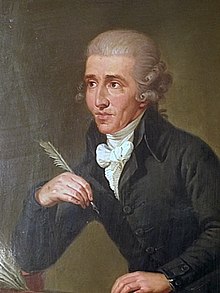
Haydn's job title under Count Morzin was Kapellmeister, that is, music director. He led the count's small orchestra and wrote his first symphonies for this ensemble.
In 1760, with the security of a Kapellmeister position, Haydn married. His wife was the former Maria Anna Aloysia Apollonia Keller (1729–1800), the sister of Therese (b. 1733), with whom Haydn had previously been in love. Haydn and his wife had a completely unhappy marriage,[16] from which the laws of the time permitted them no escape; and they produced no children. Both took lovers.[17]
Count Morzin soon suffered financial reverses that forced him to dismiss his musical establishment, but Haydn was quickly offered a similar job (1761) as Vice Kapellmeister to the Esterházy family, one of the wealthiest and most important in the Austrian Empire. When the old Kapellmeister, Gregor Werner, died in 1766, Haydn was elevated to full Kapellmeister.

As a "house officer" in the Esterházy establishment, Haydn wore livery and followed the family as they moved among their various palaces, most importantly the family's ancestral seat Schloss Esterházy in Eisenstadt and later on Eszterháza, a grand new palace built in rural Hungary in the 1760s. Haydn had a huge range of responsibilities, including composition, running the orchestra, playing chamber music for and with his patrons, and eventually the mounting of operatic productions. Despite this workload, the job was in artistic terms a superb opportunity for Haydn.[18] The Esterházy princes (first Paul Anton, then most importantly Nikolaus I) were musical connoisseurs who appreciated his work and gave him daily access to his own small orchestra.
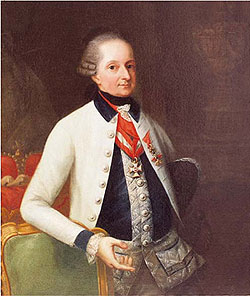
During the nearly thirty years that Haydn worked at the Esterházy court, he produced a flood of compositions, and his musical style continued to develop. His popularity in the outside world also increased. Gradually, Haydn came to write as much for publication as for his employer, and several important works of this period, such as the Paris symphonies (1785–1786) and the original orchestral version of The Seven Last Words of Christ (1786), were commissions from abroad.
Haydn also gradually came to feel more isolated and lonely, particularly as the court came to spend most of the year at Esterháza, far from Vienna, rather than the closer-by Eisenstadt.[19] Haydn particularly longed to visit Vienna because of his friendships there.[20]
Of these, a particularly important one was with Maria Anna von Genzinger (1750–93), the wife of Prince Nikolaus's personal physician in Vienna, who began a close, platonic, relationship with the composer in 1789. Haydn wrote to Mrs. Genzinger often, expressing his loneliness at Eszterháza and his happiness for the few occasions on which he was able to visit her in Vienna; later on, Haydn wrote to her frequently from London. Her premature death in 1793 was a blow to Haydn, and his F minor variations for piano, Hob. XVII:6, may have been written in response to her death.[21]
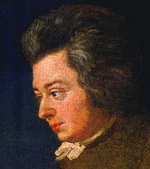
Another friend in Vienna was Wolfgang Amadeus Mozart, whom Haydn met sometime around 1784. According to later testimony by Michael Kelly and others, the two composers occasionally played in string quartets together. Haydn was hugely impressed with Mozart's work and praised it unstintingly to others. Mozart evidently returned the esteem, as seen in his dedication of a set of six quartets, now called the "Haydn" quartets, to his friend. For further details see Haydn and Mozart.
The London journeys
In 1790, Prince Nikolaus died and was succeeded by a thoroughly unmusical prince who dismissed the entire musical establishment and put Haydn on a pension. Freed of his obligations, Haydn was able to accept a lucrative offer from Johann Peter Salomon, a German impresario, to visit England and conduct new symphonies with a large orchestra.
The visit (1791–1792), along with a repeat visit (1794–1795), was a huge success. Audiences flocked to Haydn's concerts; Haydn augmented his fame and made large profits, thus becoming financially secure. Charles Burney reviewed the first concert thus: "Haydn himself presided at the piano-forte; and the sight of that renowned composer so electrified the audience, as to excite an attention and a pleasure superior to any that had ever been caused by instrumental music in England."[22]
Musically, the visits to England generated some of Haydn's best-known work, including the Surprise, Military, Drumroll, and London symphonies, the Rider quartet, and the "Gypsy Rondo" piano trio. The only misstep in the venture was an opera, Orfeo ed Euridice, also called L'Anima del Filosofo, which Haydn was contracted to compose, but whose performance was blocked by intrigues.[23]
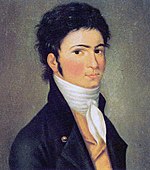
Between visits Haydn was for a time the teacher of Ludwig van Beethoven. Beethoven found Haydn unsatisfactory as a teacher and sought help from others; the relationship between the two was sometimes rather tense. For discussion of their relationship, see Beethoven and his contemporaries[24].
Final years in Vienna
Haydn returned to Vienna in 1795, moved into a large house in the suburb of Gumpendorf,[25] and turned to the composition of large religious works for chorus and orchestra. These include his two great oratorios (The Creation and The Seasons) and six masses for the Eszterházy family, which by this time was once again headed by a musically-inclined prince. Haydn also composed instrumental music: the popular Trumpet Concerto and the last nine in his long series of string quartets, including the Fifths, Emperor, and Sunrise quartets.
In 1802, an illness from which Haydn had been suffering for some time had increased in severity to the point that he became physically unable to compose. This was doubtless very difficult for him because, as he acknowledged, the flow of fresh musical ideas waiting to be worked out as compositions did not cease. Haydn was well cared for by his servants, and he received many visitors and public honours during his last years, but they could not have been very happy years for him. During his illness, Haydn often found solace by sitting at the piano and playing Gott erhalte Franz den Kaiser, which he had composed himself as a patriotic gesture in 1797.[26] This melody later was used for the Austrian and German national anthems.
Haydn died at the end of May in 1809, shortly after an attack on Vienna by the French army under Napoleon. Among his last words was his attempt to calm and reassure his servants when cannon shot fell in the neighborhood.[27] Two weeks later, a memorial service was held in the Schottenkirche on June 15, 1809, at which W.A. Mozart’s Requiem K.626 was performed.
Character and appearance
James Webster writes of Haydn's public character thus: "Haydn's public life exemplified the Enlightenment ideal of the honnête homme (honest man): the man whose good character and worldly success enable and justify each other. His modesty and probity were everywhere acknowledged. These traits were not only prerequisites to his success as Kapellmeister, entrepreneur and public figure, but also aided the favourable reception of his music."[28]. Haydn was especially respected by the Eszterházy court musicians whom he supervised, as he maintained a cordial working atmosphere and effectively represented the musicians' interests with their employer; see Papa Haydn and the tale of the "Farewell" Symphony.
Haydn had a robust sense of humour, evident in his love of practical jokes[29] and often apparent in his music; and he had many friends. For much of his life he benefited from a "happy and naturally cheerful temperament" (Dies 1810, 91), but in his later life, there is evidence for periods of depression, notably in the correspondence with Mrs. Genzinger and in Dies's biography, based on visits made in Haydn's old age.
Haydn was a devout Catholic who often turned to his rosary when he had trouble composing, a practice that he usually found to be effective.[30] He normally began the manuscript of each composition with "in nomine Domini" ("in the name of the Lord") and ended with "Laus Deo" ("praise be to God").[31]
Haydn was short in stature, perhaps as a result of having been underfed throughout most of his youth. He was not handsome, and like many in his day he was a survivor of smallpox, his face being pitted with the scars of this disease. His early biographer Dies wrote, "he couldn't understand how it happened that in his life he had been loved by many a pretty woman. 'They couldn't have been led to it by my beauty'". [32]
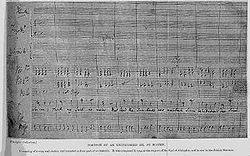
Works
James Webster summarizes Haydn's role in the history of classical music as follows:[33] "He excelled in every musical genre… He is familiarly known as the 'father of the symphony' and could with greater justice be thus regarded for the string quartet; no other composer approaches his combination of productivity, quality and historical importance in these genres."
Structure and character of the music
A central characteristic of Haydn's music is the development of larger structures out of very short, simple musical motifs, often derived from standard accompanying figures. The music is often quite formally concentrated, and the important musical events of a movement can unfold rather quickly.[34]
Haydn's work was central to the development of what came to be called sonata form. His practice, however, differed in some ways from that of Mozart and Beethoven, his younger contemporaries who likewise excelled in this form of composition. Haydn was particularly fond of the so-called "monothematic exposition", in which the music that establishes the dominant key is similar or identical to the opening theme. Haydn also differs from Mozart and Beethoven in his recapitulation sections, where he often rearranges the order of themes compared to the exposition and uses extensive thematic development.[35]
Haydn's formal inventiveness also led him to integrate the fugue into the classical style and to enrich the rondo form with more cohesive tonal logic (see sonata rondo form). Haydn was also the principal exponent of the double variation form – variations on two alternating themes, which are often major- and minor-mode versions of each other.
Perhaps more than any other composer's, Haydn's music is known for its humour.[citation needed] The most famous example is the sudden loud chord in the slow movement of his "Surprise" symphony; Haydn's many other musical jokes include numerous false endings (e.g., in the quartets Op. 33 No. 2 and Op. 50 No. 3), and the remarkable rhythmic illusion placed in the trio section of the third movement of Op. 50 No. 1.
Much of the music was written to please and delight a prince, and its emotional tone is correspondingly upbeat.[citation needed] This tone also reflects, perhaps, Haydn's fundamentally healthy and well-balanced personality. Occasional minor-key works, often deadly serious in character, form striking exceptions to the general rule. Haydn's fast movements tend to be rhythmically propulsive and often impart a great sense of energy, especially in the finales. Some characteristic examples of Haydn's "rollicking" finale type are found in the "London" symphony No. 104, the string quartet Op. 50 No. 1, and the piano trio Hob XV: 27. Haydn's early slow movements are usually not too slow in tempo, relaxed, and reflective. Later on, the emotional range of the slow movements increases, notably in the deeply felt slow movements of the quartets Op. 76 Nos. 3 and 5, symphony No. 102, and piano trio Hob XV: 23. The minuets tend to have a strong downbeat and a clearly popular character. As early as Op. 33 (1781) Haydn turned some of his minuets into "scherzi" which are much faster, at one beat to the bar.
Evolution of Haydn's style
Haydn's early work dates from a period in which the compositional style of the High Baroque (seen in Bach and Handel) had gone out of fashion. This was a period of exploration and uncertainty, and Haydn, born 18 years before the death of Bach, was himself one of the musical explorers of this time.[36] An older contemporary whose work Haydn acknowledged as an important influence was Carl Philipp Emanuel Bach.[37]
Tracing Haydn's work over the five decades in which it was produced (roughly, 1749 to 1802), one finds a gradual but steady increase in complexity and musical sophistication, which developed as Haydn learned from his own experience and that of his colleagues. Several important landmarks have been observed in the evolution of Haydn's musical style.
In the late 1760s and early 1770s Haydn entered a stylistic period known as "Sturm und Drang" (storm and stress). This term is taken from a literary movement of about the same time, though it appears that the musical development actually preceded the literary one by a few years.[38] The musical language of this period is similar to what went before, but it is deployed in work that is more intensely expressive, especially in the works in minor keys. James Webster describes the works of this period as "longer, more passionate, and more daring."[39] Some of the most famous compositions of this time are the "Farewell" Symphony No. 45, the piano sonata in C minor (Hob. XVI/20, L. 33), and the six string quartets of Op. 20 (the "Sun" quartets), all from 1772. It was also around this time that Haydn became interested in writing fugues in the Baroque style, and three of the Op. 20 quartets end with such fugues.
Following the climax of the "Sturm und Drang", Haydn returned to a lighter, more overtly entertaining style. There are no quartets from this period, and the symphonies take on new features: the first movements now sometimes contain slow introductions, and the scoring often includes trumpets and timpani. These changes are often related to a major shift in Haydn's professional duties, which moved him away from "pure" music and toward the production of comic operas. Several of the operas were Haydn's own work (see List of operas by Joseph Haydn); these are seldom performed today. Haydn sometimes recycled his opera music in symphonic works,[40] which helped him continue his career as a symphonist during this hectic decade.
In 1779, an important change in Haydn's contract permitted him to publish his compositions without prior authorization from his employer. This may have encouraged Haydn to rekindle his career as a composer of "pure" music. The change made itself felt most dramatically in 1781, when Haydn published the six string quartets of Opus 33, announcing (in a letter to potential purchasers) that they were written in "a completely new and special way". Charles Rosen has argued that this assertion on Haydn's part was not just sales talk, but meant quite seriously; and he points out a number of important advances in Haydn's compositional technique that appear in these quartets, advances that mark the advent of the Classical style in full flower. These include a fluid form of phrasing, in which each motif emerges from the previous one without interruption, the practice of letting accompanying material evolve into melodic material, and a kind of "Classical counterpoint" in which each instrumental part maintains its own integrity. These traits continue in the many quartets that Haydn wrote after Opus 33.[41]
In the 1790s, stimulated by his England journeys, Haydn developed what Rosen calls his "popular style", a way of composition that, with unprecedented success, created music having great popular appeal but retaining a learned and rigorous musical structure.[42] An important element of the popular style was the frequent use of folk or folk-like material, as discussed in the article Haydn and folk music. Haydn took care to deploy this material in appropriate locations, such as the endings of sonata expositions or the opening themes of finales. In such locations, the folk material serves as an element of stability, helping to anchor the larger structure.[43] Haydn's popular style can be heard in virtually all of his later work, including the twelve London symphonies, the late quartets and piano trios, and the two late oratorios.
The return to Vienna in 1795 marked the last turning point in Haydn's career. Although his musical style evolved little, his intentions as a composer changed. While he had been a servant, and later a busy entrepreneur, Haydn wrote his works quickly and in profusion, with frequent deadlines. As a rich man, Haydn now felt he had the privilege of taking his time and writing for posterity. This is reflected in the subject matter of The Creation (1798) and The Seasons (1801), which address such weighty topics as the meaning of life and the purpose of humankind, and represent an attempt to render the sublime in music. Haydn's new intentions also meant that he was willing to spend much time on a single work: both oratorios took him over a year to complete. Haydn once remarked that he had worked on The Creation so long because he wanted it to last.[44]
The change in Haydn's approach was important in the history of music, as other composers soon were following his lead. Notably, Beethoven adopted the practice of taking his time and aiming high.[45]
Identifying Haydn's works
Haydn's works are listed in a comprehensive catalogue prepared by Anthony van Hoboken. This Hoboken catalogue provides each work with an identifying number, called its Hoboken number (abbreviation: H. or Hob.). The string quartets also have Hoboken numbers, but are usually identified instead by their opus numbers, which have the advantage of indicating the groups of six quartets that Haydn published together; thus for example the string quartet Opus 76, No. 3 is the third of the six quartets published in 1799 as Opus 76.
Media
Template:Multi-listen start Template:Multi-listen item Template:Multi-listen item Template:Multi-listen item Template:Multi-listen item Template:Multi-listen item Template:Multi-listen item Template:Multi-listen item Template:Multi-listen end
See also
Works
General
- Category of compositions by Joseph Haydn
- List of concertos by Joseph Haydn
- List of masses by Joseph Haydn
- List of operas by Joseph Haydn
- List of piano trios by Joseph Haydn
- List of string quartets by Joseph Haydn
- List of symphonies by Joseph Haydn
Vocal works
Contemporaries
- Marianne von Martinez — as a child one of Haydn's first students; as an adult a friend and an eminent musician in her own right
- Johann Peter Salomon - organizer of the London journeys
- Gottfried van Swieten - the librettist of The Creation and The Seasons
- List of Austrians in music
Other topics
- Haydn and folk music
- Haydn's head - how it was stolen after his death
- Joseph Haydn's ethnicity - an old controversy: was Haydn a Croatian?
- "Papa" Haydn
- Mannersdorf am Leithagebirge - where Haydn visited and built his career during summer 1753
Further reading
Biography
- Dies, Albert Christoph (1810) Biographical Accounts of Joseph Haydn, Vienna. English translation by Vernon Gotwals, in Haydn: Two Contemporary Portraits, Milwaukee: University of Wisconsin Press. One of the first biographies of Haydn, written on the basis of 30 interviews carried out during the composer's old age.
- Geiringer, Karl, in collaboration with Irene Geiringer (3rd ed., 1982) Haydn: A Creative Life in Music. Berkeley: University of California Press.
- Griesinger, Georg August (1810) Biographical Notes Concerning Joseph Haydn. Leipzig: Breitkopf und Härtel. English translation by Vernon Gotwals, in Haydn: Two Contemporary Portraits, Milwaukee: University of Wisconsin Press. Like Dies's, a biography produced from interviews with the elderly Haydn.
- Hughes, Rosemary (1970) Haydn (New York: Farrar Strauss and Giroux). Gives a sympathetic and witty account of Haydn's life, along with a survey of the music.
- Larsen, Jens Peter (1980) "Joseph Haydn," article in the 1980 edition of the New Grove. Published separately as The New Grove: Haydn, Norton, New York, 1982.
- Robbins Landon, H.C. (1976-1980) Haydn: Chronicle and Works, Bloomington, IN: Indiana University Press. An extensive compilation of original sources in five volumes.
- Robbins Landon, H.C. and David Wyn Jones (1988) Haydn: His Life and Music, Thames and Hudson. Biography chapters by Robbins Landon, excerpted from Robbins Landon (1976-1980) and rich in original source documents. Analysis and appreciation of the works by Jones.
- Webster, James, and Georg Feder (2001), "Joseph Haydn", article in The New Grove Dictionary of Music and Musicians (New York: Grove, 2001). Published separately as a book: The New Grove Haydn (New York: Macmillan 2002, ISBN 0-19-516904-2). Up-to-date scholarship with little subjective interpretation.
Criticism and analysis
- Clark, Caryl, ed. (2005) The Cambridge Companion to Haydn (Cambridge; Cambridge University Press; ISBN 0-521-83347-7). Covers each of the genres Haydn composed in as well as stylistic and interpretive contexts and performance and reception.
- Griffiths, Paul (1983) The String Quartet (Great Britain: Thames and Hudson).
- Hughes, Rosemary (1966) Haydn String Quartets (London: BBC 1966) is a brief (55 page). Introduction to Haydn's string quartets.
- Rosen, Charles (1971 and 1997) The Classical Style (2nd ed., New York: Norton 1997; ISBN 0-393-31712-9). Covers much of Haydn's output and seeks to explicate Haydn's central role in the creation of the classical style. The work has been influential, provoking both positive citation and work (e.g., Webster 1991) written in reaction.
- Sutcliffe, W. Dean (1992) "Haydn's Musical Personality," The Musical Times. 130:341-344.
- Sutcliffe, W. Dean (1992) Haydn String Quartets, Op. 50 (Cambridge: Cambridge University Press). Covers not just Op. 50 but also its relevance to Haydn's other output as well as his earlier quartets.
- Webster, James (1991) Haydn's "Farewell" Symphony and the Idea of Classical Style (Cambridge University Press, 1991, ISBN 0-521-38520-2). This book focuses on a single work, but contains many observations and opinions about Haydn in general.
Scores and recordings
- Template:IckingArchive
- Works by Joseph Haydn at Project Gutenberg
- Free scores by Joseph Haydn at the International Music Score Library Project (IMSLP)
- Kunst der Fuge: Franz Joseph Haydn - Hundreds of MIDI files
- The Joke (op. 33 no. 2) rights cleared extract
- Missa Brevis Sancti Johannis de Deo MP3 Creative Commons Recording
- Haydn's page at Classical Archives
- Franz Joseph Haydn on Naxos Records
References
- ^ Although he is still often called "Franz Joseph Haydn", the name "Franz" was not used in the composer's lifetime and is avoided by scholars. (Webster, James: "Haydn, Joseph", Grove Music Online ed. L. Macy (Accessed 18 January 2007), http://www.grovemusic.com)
- ^ Pronunciation in German (IPA) is [ˈjoːzɛf ˈhaɪdn̩], in English [ˈdʒoʊzəf ˈhaɪdn̩]
- ^ Griesinger 1810, 24–25
- ^ Dies 1810, 80–81
- ^ Griesinger 1810, 9
- ^ Dies 1810, 82
- ^ Dies 1801, 87
- ^ Robbins Landon and Jones 1988, 27
- ^ Geiringer, 27
- ^ Larsen 1980, 8
- ^ Geiringer, 30
- ^ Geiringer 30–2
- ^ Griesinger 1810, 15
- ^ This date is uncertain, since the early biography of Griesinger 1810 gives 1759. For the evidence supporting the earlier date see Robbins Landon and Jones (1988, 34) and Webster (2002, 10)).
- ^ Source for this paragraph: Geiringer, 34–5
- ^ See, e.g., Geiringer 1982, 36–40
- ^ Mrs. Haydn's paramour (1770) was Ludwig Guttenbrunn, an artist who produced the portrait of Haydn seen above (Robbins Landon and Jones, 1988, 109). Joseph Haydn had a long relationship, starting in 1779, with the singer Luigia Polzelli, and was probably the father of her son Antonio (Robbins Landon and Jones 1988, 116).
- ^ This view is given, for instanc, by Webster (2002, 13) and Robbins Landon and Jones (1988, 37).
- ^ Geiringer 1982, 60
- ^ For details see Geiringer 1982, Chapter 6
- ^ Geiringer 1982, 316, citing Robbins Landon
- ^ From Burney's memoirs; quoted from Robbins Landon and Jones (1988, 234)
- ^ The premier performance occurred only in 1951, at the Florence May Festival with Maria Callas in the role of Euridice. The opera and its history are discussed in Geiringer (1982, 342–3).
- ^ Geiringer (1982, 131–135.
- ^ The house, at Haydngasse 19, has since 1899 been a Haydn museum ([1], [2]).
- ^ Geiringer 1982, 161–2
- ^ Geiringer 1982, 189
- ^ Webster 2002, 44
- ^ See Griesinger 1810, 20, Dies 1810, 92–93,
- ^ Griesinger 1810, 54
- ^ Larsen 1980, 81
- ^ Dies 1810, 157; translation taken from Robbins Landon and Jones 1988
- ^ Online edition, article "Joseph Haydn"; downloaded Feb. 3, 2007
- ^ Sutcliffe (1989, 343) mentions this in a criticism of contemporary Haydn performance practice: "[Haydn's] music sometime seems to 'live on its nerves' ... It is above all in this respect that Haydn performances often fail, whereby most interpreters lack the mental agility to deal with the ever-changing 'physiognomy' of Haydn's music, subsiding instead into an ease of manner and a concern for broader effects that they have acquired in their playing of Mozart."
- ^ Hughes (1970, 112) writes: "Having begun to 'develop', he could not stop; his recapitulations begin to take on irregular contours, sometimes sharply condensed, sometimes surprisingly expanded, losing their first tame symmetry to regain a balance of a far higher and more satisfying order."
- ^ Rosen (1997, 57) writes, "the period from 1750 to 1775 was penetrated by eccentricity, hit-or-miss experimentation, resulting in works which are still difficult to accept today because of their oddities." Similar remarks are made by Hughes (1970, 111–112)
- ^ Charles K. Moss. "Carl Phillip Emanuel Bach". Carolina Classical Connection.
- ^ See Webster (2002, 18): "the term has been criticized: taken from the title of a play of 1776 by Maximilian Klinger, it properly pertains to a literary movement of the middle and late 1770s rather than a musical one of about 1768–1772."
- ^ Webster (2002, 18)
- ^ Webster and Feder 2001, section 3.iii
- ^ Rosen's case that Opus 33 represents a "revolution in style" (1971 and 1997, 116) can be found in chapter III.1 of (Rosen 1971 and 1997). For dissenting views, see Larsen (1980, 102) and Webster (1991).
- ^ Rosen discusses the popular style in ch. VI.1 of Rosen (1971 and 1997).
- ^ Rosen (1997 and 2001), 333–337
- ^ Geiringer 1982, 158
- ^ For discussion, see Antony Hopkins (1981) The Nine Symphonies of Beethoven, Heinemann, London, pp. 7–8.
External links
- Free scores by Joseph Haydn in the Choral Public Domain Library (ChoralWiki)
- Free Scores be Haydn, Joseph at the International Music Score Library Project.
- Haydn's Late Oratorios: The Creation and The Seasons by Brian Robins
- Catalogue of works of Franz Joseph Haydn
- Joseph Haydn and the Classical Era
- Full text of the biography Haydn by J. Cuthbert Hadden, 1902, from Project Gutenberg. The end of book contains documentary material including a number of Haydn's letters.
- No Royal Directive: Joseph Haydn and the String Quartet by Ron Drummond
- musicologie.org, with biography (in French)
- Haydn Cello Concerto in C- last movement
- Joseph Haydn Free Piano Scores
